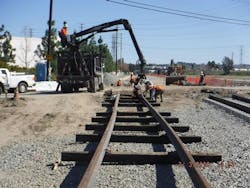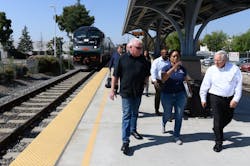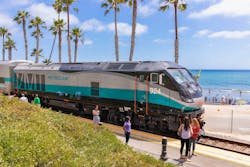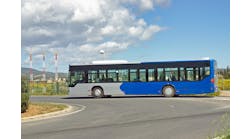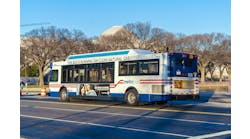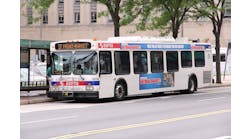Zero-Emissions Technology Fast-Tracked for Rail System Expansion Project
By: Sherita Coffelt and Paul Gonzales
There will be cleaner skies and a more reliable ride across sunny SoCal this fall as Metrolink deploys its 40th and final Tier 4 clean diesel locomotive.
These locomotives reduce emissions by up to 85% compared to Metrolink’s oldest Tier 0 locomotives and meet the Environmental Protection Agency’s most stringent emissions standards. Metrolink was one of the first commuter rail agencies in the nation to purchase these new locomotives back in 2013, but the agency is already looking to the next innovation in environmentally friendly commuter rail transportation.
About Metrolink
Metrolink is Southern California’s passenger railroad operating over a 538-mile system, servicing six counties. It is the third largest commuter railroad in the nation based on route miles. From 2015-2019, Metrolink enjoyed yearly growth in ridership with a record of nearly 12 million boardings set in fiscal year 2019-2020.
The average Metrolink one-way trip is 36 miles. Eighty-five percent of system riders say they own a private vehicle but choose Metrolink to reduce the stress and cost of commuting. This means that approximately 85% of Metrolink boardings represent a freeway trip not taken, resulting in less congestion and emissions on the roadways.
Metrolink serves as the backbone of the Southern California transportation system, creating an essential link between more affordable inland communities to job centers in Los Angeles and Orange counties. Traditionally, Metrolink has been viewed as a commuter rail agency. However, the ridership base is diversifying to include more evening and weekend trips.
The future is now
When Stephanie Wiggins joined Metrolink as Chief Executive Officer (CEO) in January 2019, she unveiled a customer-focused vision. She vowed to continue to operate the safest railroad possible while modernizing business practices and creating an integrated system that allows Southern Californians to ditch their vehicles for good. It wasn’t long before she started to talk about Metrolink’s “zero-emissions future” which was well-received by the Metrolink Board of Directors, employees and especially the communities adjacent to the Metrolink system. Little did they know that when she talked about the future, she believed the future was already here.
With a fast-paced “the future is now” attitude, Metrolink has joined with the San Bernardino County Transportation Authority (SBCTA) on a $359.7 million, 9-mile rail line to connect the city of Redlands with the regional rail hub in downtown San Bernardino. The line will operate as the Arrow service and will extend Metrolink’s most popular route, the San Bernardino Line, further east to a newly built station at the University of Redlands. The station, nearly 80 miles from downtown Los Angeles, will provide connectivity with cars, buses, and bicycles.
This project is scheduled to begin operations in early 2021, using eco-friendly diesel multiple units (DMUs) to operate along the line. DMUs are widely used in Europe and powered by an onboard, low-emission clean diesel engine that is smaller, quieter, and more efficient than standard diesel locomotives. DMUs also can operate on the same tracks shared by other railroads. This is another step forward for clean air, but there is still room for improvement.
Early on, SBCTA recognized an opportunity to convert the diesel power generator to zero-emission multiple units (ZEMU), which would make Metrolink’s Arrow service the first extension with such rail technology in the U.S. In 2024, these ZEMUs will make their debut.
“Metrolink provides an essential service for Southern Californians, connecting affordable housing to job and activity centers across the region,” Metrolink CEO Stephanie Wiggins said. “This is an exciting project because it allows us to offer more people more service while operating in the most environmentally friendly way possible. It will truly benefit the entire region and commuter rail industry.”
Zero-emissions technology grant
To advance the clean-air component of Arrow, SBCTA secured a $30 million California Transit and Intercity Rail Capital Program (TIRCP) grant for research and development necessary to purchase a zero-emission vehicle and convert a DMU to a ZEMU. Additionally, construction is required for necessary infrastructure to support the alternative propulsion technology and test the vehicle on the Arrow service corridor.
“After much review and evaluation of various technologies, hydrogen fuel cell was selected as the technology for the Arrow service,” said City of Highland Mayor Larry McCallon—who also is Vice Chair of the Metrolink Board of Directors and sits on SBCTA’s board.
Fuel cell technology uses hydrogen and oxygen in a chemical reaction to make energy. Fuel cells are a kind of battery that are in use to power buildings and automobiles, emitting only water vapor. Power packs and hydrogen tanks will be installed onboard the train, between two train cars.
Last November, SBCTA signed a $23 million agreement with Stadler Rail AG of Switzerland to develop the FLIRT HW ZEMU, powered by hydrogen.
In recognition of the innovation of the Redlands Passenger Rail Project, SBCTA was honored with a 2020 Sustainability Award from the Southern California Association of Governments.
At its terminus in downtown San Bernardino, Arrow service will meet the Metrolink system with connections west to downtown Los Angeles and south to the City of Riverside and to destinations in Orange and San Diego counties.
“Creating innovative, convenient options to meet the transportation needs of our region is critical to moving people and goods effectively and efficiently,” SBCTA President Darcy McNaboe said.
More about Metrolink’s zero-emissions future
On the opposite end of its service area, Metrolink is also a partner on a pilot project with the Los Angeles County Metropolitan Transportation Authority (Metro) to use zero-emission technology to operate on Metrolink’s Antelope Valley Line. A $107 TIRCP grant is helping to finance the effort that is scheduled to begin in the summer of 2022 and operate through December 2024.
In a similar vein to the Arrow service, Metrolink’s clean-air project with Metro involves conversion of a DMU to a ZEMU to operate on a line that connects downtown Los Angeles through the San Fernando Valley to the high desert cities of Palmdale and Lancaster. Disadvantaged communities along that corridor have long suffered from lung-burning air pollution and dependence on the personal vehicle.
“We are also looking at ways to convert our older locomotives to Tier-4 or even zero emissions technologies, and the experience we gain in these two projects will help guide us on the path forward,” Wiggins said.
Annually, Metrolink service reduces freeway congestion by 9.3 million car trips, thereby eliminating 339,328,158 vehicle miles traveled. The environmental benefits include reducing greenhouse gas emissions by 130,000 metric tons every year which is the equivalent to the amount of carbon removed by 158,000 acres of forest.
To learn more about Metrolink, visit www.metrolinktrains.com.
About The Author: Coffelt is Director Of Communications for Metrolink. Gonzales is Public Affairs Manager for Metrolink.
